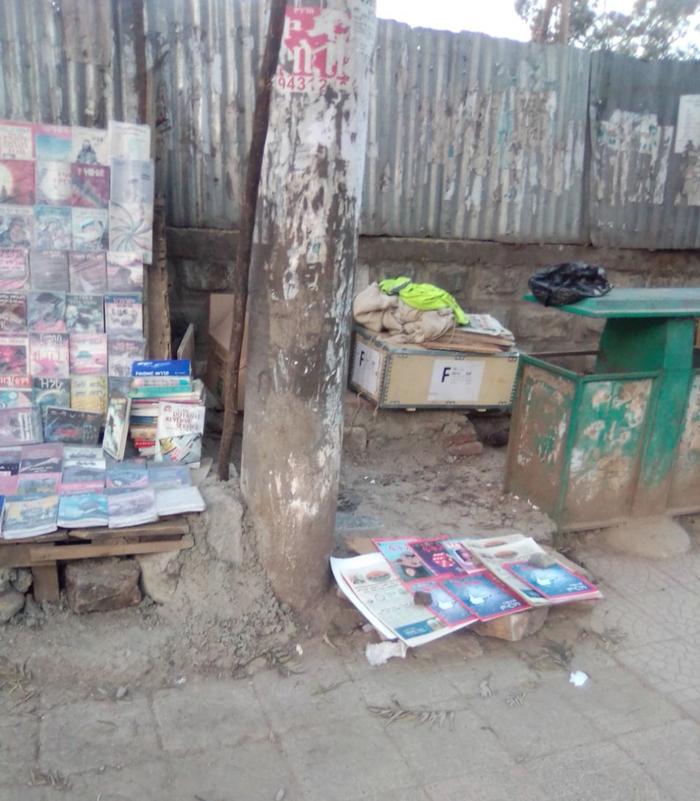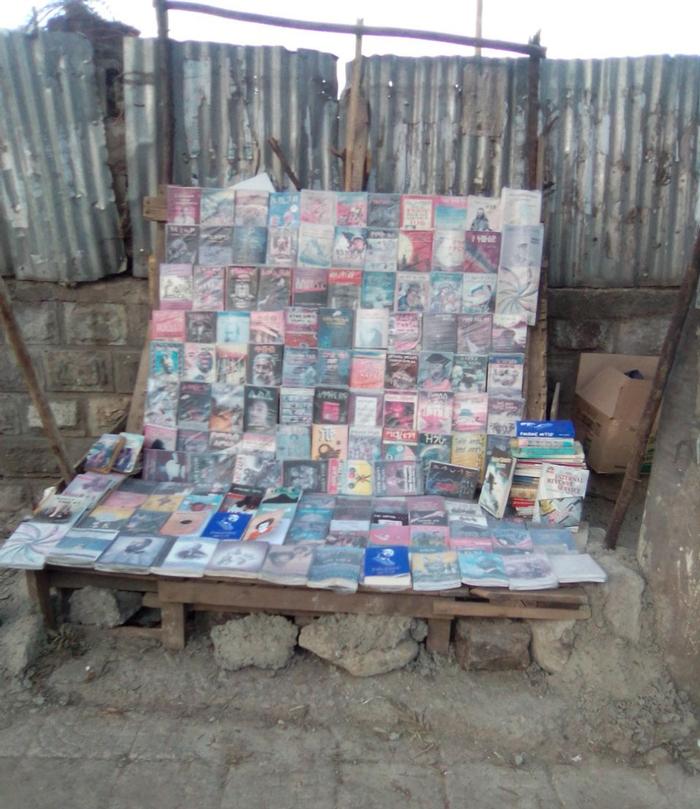Winta Assefa - ProposalThe Mobile Library'The Mobile Library' About the context + target group: Most days a week, Abraham carries several kilograms of books to his chosen site in Gergi. He makes a living out of selling these books to pedestrians and drivers caught in the often-heavy Gergi Mebrathail traffic. Gergi is a newly populated neighborhood of Addis Ababa, and I only moved to this part of town after my mother arrived in Ethiopia in 2017. So, I've always known this place as a bustling, mainly residential neighborhood. Gergi also has many mixed-use apartment complexes, a branch of the first privately owned university in Ethiopia, several privately owned schools, and one of the country's largest hospitals-which has its medical college. All of these developments lead to the influx of students and their parents from all over the city. People like Abraham and his colleagues are trying to tap into this market through whatever means they can afford. One way they do that is by forming networks amongst each other. This way, if one of them doesn't have a book that a customer wants, they ask each other for a copy. Abraham used to carry a large backpack filled with books around, and he held the books he wanted to showcase in both his arms. But having saved up enough money, he was able to make a semi-permanent display with timber and stones. His colleagues still carry around books the way he used to, though. He said that he wonders about whether he should buy a large trolley to carry the books around. By stationing his books in one area, he lost a certain element of mobility. But the previous arrangement had taken a toll on his health. He said that there were times when he'd fallen on his back because the books in the backpack were heavier than he could handle. There are marks on his wrists from all the books he carried there. Lifting heavy weights can cause musculoskeletal injuries (MSIs), including strains and sprains. The risk of such injuries gets even worse when twisting, bending, and carrying weights with awkward postures-all of which are things these booksellers tend to do. They're also frequently chased away by officials on the road. Given their role in this thriving region, I believe that these young people deserve some support. This project can begin advocating for this widely stationed group of people, so government agents don't hinder them anymore. This prototype can demonstrate that these booksellers should be promoted as positive agents in the wider urban culture. Ultimately, the government could give them fixed areas in different neighborhoods all over the city, so customers would know where to find them. It may be challenging to dedicate a space for any one thing in an already overcrowded city like Addis Ababa. But small 'injections' like this one can begin an intellectual revolution in a country where a large proportion of the population is under thirty years old. This urban phenomenon would cater to the millions of pedestrians-students on their daily commutes, the many employees waiting in line for their minibusses, people getting their shoes cleaned, etc. Such stolen moments could add up to many reading hours over the years. So far, locals had mainly gotten used to seeing groups of readers under the Arat Kilo bridge; people had been gathering there to read their newspapers for decades now. We don't see much of that in any other neighborhood. But the phenomenon could become much more widespread than that. Ultimately, this project can end up taking the form of an adjustable, mobile shelf unit. A motorized element can be added to the design if needed. Through the fellowship, I hope to design the prototype with a couple of local book sellers-like Abraham-and include them as consultants throughout the process. Then, depending on the form the design takes, I hope to build at least one prototype of the design either by using their skills or by hiring a local carpenter. To help us stay within constraints caused by mobility and the budget, I set a volumetric upper limit for the prototype (2 meters cubed when packed to go). As I'd written in my essay, our designs' main shortcoming in university may have been the fact that we never went back to the people we drew our research from. But since this is a small-scale project that I hope to implement, I want to try a different way. I'll bring simple materials like glue, drafting paper, paper, and crafting paper, lay them all down on a small table, and make several mockup models where the booksellers work. We can change up the models and make new ones on the spot. Simultaneously, I'll consult with colleagues and faculty members at my university to ensure the design is structurally stable. Then through several outdoor sessions, we can develop a design that the whole group is happy with. That's when I could start making the technical drawings. I hope to build the prototype(s) shortly after that. Now, I never ended up seeing the form my designs would take in reality. I never saw if they would be feasible or how they would look when time passes, and dust inevitably starts creeping into them. Would they get a panache through the years? Would they be used the way I intended them to? Would the ones we're designing for like the solution we present them with? Since I never had the chance to experience those things in school, two things happened: I found myself simultaneously detached from the project I invested so much time on and too attached to how my idea itself would come across 'on paper.' That sort of mentality shielded me from the vulnerability, humility, and level of pragmatism it would take to build a project with the end-user in mind. Now that I'm at the end of my university education, I believe this would allow me to exercise all the technical skills I gained over the years while learning more about the local building industry. I hope that I'll learn how to collaborate with a small team to make the most of the resources at hand. Project time-table: Conceptualization + Participatory (4 days; June 5-June 9, 2021) Making Detailed Technical Drawings + Material selection (5 days; June 10-June 15, 2021) Acquiring Materials (4 days; June 16-June 19, 2021) Preparation + Building the Prototype (21 days; June 20-July 10, 2021) Testing the Prototype (2 days; July 11-13, 2021) Review Work + Make Any Necessary Changes (5 days; July 14-July 18, 2021) Host Small Outdoor Opening Event with the Booksellers and the new Prototype. Through a livestream, let the young people demonstrate how the prototype could be used and adjusted, and make their location known. Invite local photographers and other creative friends to attend the event and bring in their own coverage.
Estimated cost breakdown for one unit: 1.2m x 2m aluminum sheet (for sealing corners or adding compartments within the prototype(s) ($150) Fiberglass ($350) Carpentry work ($60) Canvas or other foldable element ($70) Wood ($200) Wheels and joint elements ($90) Stipends for the booksellers/co-designers ($40) Total transportation costs ($200) Miscellaneous/unforeseen expenses ($50) To make up to three prototypes: $1210 x 3 = $3630 To host the outdoor opening event (with a livestream): $3630 + $50 = $3680 Total budget: $3680 Additional Help and InformationAre you in need of assistance? Please email info@berkeleyprize.org. |
|


